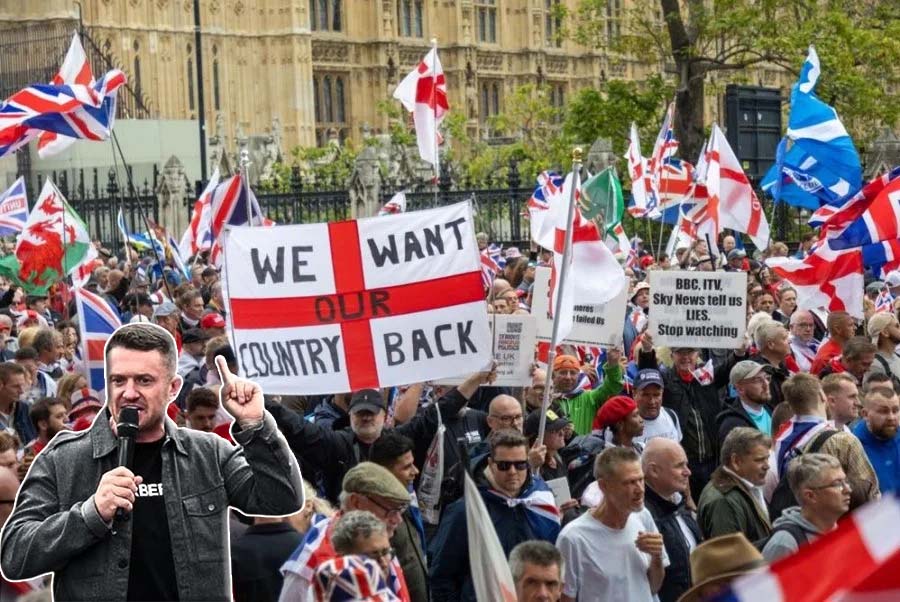
- One of the largest far-right protests in modern British history erupted in London on September 13, 2025, led by Tommy Robinson, fueled by online mobilisation, and anger over immigration.
- The protests followed months of unrest triggered by crimes involving migrants, housing shortages, and rhetoric from far-right groups, with clashes leaving 26 police officers injured and 25 protesters arrested.
- Rising anti-immigrant sentiment in the UK mirrors global trends, influenced by Trump’s return in the US, far-right gains in Europe, economic stagnation, cultural fears, and record migration figures.
- The movement pressures the UK government to tighten borders and deportations, heightening divisions between native Britons, legal immigrants, and illegal migrants amid fears over identity, culture, and security.
On September 13, 2025, in the rain-soaked streets of central London, a sea of Union Jacks and St. George’s crosses rushed into Trafalgar Square, yelling, “We want our country back!” What began as a “Unite the Kingdom” gathering swiftly grew into one of the largest far-right protests in contemporary British history, with an estimated 110,000 to 150,000 people attending.[1] This wasn’t simply a rally; it was a watershed moment in a larger mobilisation that has grabbed the United Kingdom, combining rage, anxiety, and a powerful undercurrent of nationalism. The crowd surged, led by far-right activist Tommy Robinson, representing a movement that is transforming British politics and society.
However, this was not a spontaneous outburst. It was the unavoidable result of months of increasing strain. This was not an isolated instance. It came after a summer of instability, including rioting in July 2025, in response to Reform UK leader Nigel Farage’s warnings about probable “civil disobedience”.[2] The turmoil in July and August 2024, precipitated by reports tying a Muslim migrant to the stabbing deaths of three girls in Southport, had already strained communities.[3]
Early protests in Essex’s Epping over housing shortages and criminality erupted into nationwide rallies fueled by rage. By September 2025, the campaign had become a rallying cry for those who felt overlooked, displaced, or deceived by government leaders.
What Happened?
Tommy Robinson, born Stephen Yaxley-Lennon, has been at the centre of the disturbance. Robinson, a former tanning salon owner from Luton, co-founded the English Defence League in 2009, amid anti-Islam protests. Since then, he has continually reinvented himself, from prison time for mortgage fraud and contempt of court to posturing as a self-proclaimed journalist and anti-immigrant campaigner.[4] His documentaries on grooming gangs and the dangers to British values have garnered him a devoted audience. The protests began in mid-July 2025, following the arrest of an Ethiopian asylum seeker suspected of sexual assault just days after landing in the UK.[5] Demonstrations began in Epping, outside a hotel that houses asylum seekers, and swiftly extended to Bristol, Manchester, and Newcastle.
By September 13, the movement had culminated in a major London march, during which tensions boiled over. Protesters battled with police, throwing objects and assaulting them, which injured 26 policemen and resulted in 25 arrests. Counter-protesters, including left-wing heavyweights such as John McDonnell and Diane Abbott, gathered to oppose the far-right narrative, but it dominated the day.[6] The mobilisation was planned online and via far-right networks and perpetuated on social media, with parties such as Britain First, Homeland Party, and Patriotic Alternative accused of fanning the flames. Elon Musk even beamed in via video link, criticising Prime Minister Keir Starmer’s government and echoing calls for tougher borders.[7]
Britain's concerns are similar to those across Europe: slow post-pandemic growth, inflation, energy issues, and fears of cultural dilution.
A Global Backdrop
To decipher this UK mobilisation, look across the Atlantic and the continent. US President Donald Trump’s triumphal comeback to the White House in 2025 has fueled global anti-immigrant sentiment. Trump’s promises of mass deportations, aimed at millions of undocumented migrants, have resonated with Britain, where his tough tone may fuel calls for similar crackdowns. If Trump’s plans hurt U.S. industries such as agriculture and construction, it may highlight concerns here, but his rhetoric is already fueling UK calls for harsher asylum regulations. During his visit to the UK, Trump avoided direct endorsement but applauded the intensity of the protests, implying that Starmer’s softer attitude encourages instability.[8]
Marine Le Pen’s National Rally nearly brought down France’s government.[9] Italy’s Giorgia Meloni strengthened her grip on power, while Austria’s Freedom Party rose in legislative elections. The Alternative for Germany pushed the EU’s migrant agreements even further right. Together, these trends indicate a continental reaction against the unequal rewards of globalisation.
Britain’s concerns are similar to those across Europe: slow post-pandemic growth, inflation, energy issues, and fears of cultural dilution. With net migration in Britain reaching a record 906,000 in 2023[10] and Channel crossings exceeding 25,000 in 2025. [11] Immigration is perceived as a threat and not as an opportunity.
Numbers That Feed the Narrative
The immigrant effect issue is not a recent phenomenon. Migrants contribute to the British economy, from the NHS[12] to the technology sector.[13] According to research, immigration boosts GDP and has a beneficial budgetary impact.[14] However, when people are up against a wall, those statistics signify little. Fear gets worse by shifting demographics. 18% of the population is now foreign-born.[15] From complaints about halal meat to modifications on the high street, these developments are interpreted as attempts to eradicate British culture.[16] Nearly half of the population believes that there are more illegal immigrants in Britain than there are those with visas and work cards.
Crime compounds the situation even further. In some places, immigrants account for up to 23% of sexual offences.[17] The Rotherham episode, for example, in which over 1,400 girls were sexually abused by Pakistani men between 1997 and 2013, shattered community faith.[18] Even in 2025, a review showed that police were punished for failing to share ethnicity data on some arrests for fear of being accused of racism. Nonetheless, complaints of “two-tier policing” are levied, leaving too many areas feeling forgotten.
What It Means: For Britons, Legal, and Illegal Immigrants
This mobilisation creates a new schism for British citizens. The white working class now appears to have a voice where it previously had not, but it may ignore other ethnic populations in the process. It will also put further pressure on Starmer’s administration to crack down, discouraging even more individuals from legal migration efforts and increasing deportations, similar to Trump’s takeover. Despite their contributions, legal immigrants, from Indian physicians in the NHS to Polish builders on construction sites, are sometimes viewed with distrust by the general population. Meanwhile, illegal immigrants, who are already vulnerable, confront greater enforcement, higher deportation costs, and potentially fatal routes over the Channel.
The rally’s most disturbing message is this: Britain’s identity is at risk. As one demonstrator put it frankly, “We need to decide who’s gonna come over and be a productive citizen.” It remains to be seen whether this subject will spark discourse or division.
Finally, this anti-immigrant movement requires a balance between global developments and local concerns. Britain must address some concerns, such as employment, culture, and crime, without fracturing. As one banner read, “Whose street?” “Our street” The broader question, however, is, “Whose Britain will be created?“
References:
- [1] Over one lakh join London anti-immigration rally; 26 police officers injured in clashes
- [2] UK’s Farage unveils plan to deport asylum seekers, warns of ‘civil disorder’
- [3] 2024 United Kingdom riots
- [4] Thousands fill London streets for “Unite the Kingdom” rally organized by far-right activist Tommy Robinson
- [5] Asylum seeker in UK found guilty of sex assault on teen that sparked protests
- [6] Far-right anti-immigration protests in London lead to clashes with police
- [7] Give our country back: How anti-immigration tsunami swept London
- [8] Trump flies in for a UK state visit where trade and tech talks mix with royal pomp
- [9] The lesson from the last time Marine Le Pen knifed a French prime minister
- [10] Net migration to the UK
- [11] Channel crossings in 2025 pass 25,000 – faster than any year since records began
- [12] Record one in five NHS staff in England are non-UK nationals, figures show
- [13] Migrants in the UK labour market: an overview
- [14]Net migration forecast and its impact on the economy
- [15]Migration statistics
- [16] MPs criticise halal slaughter debate: ‘about prejudice, not animals’
- [17] Foreign nationals responsible for nearly a QUARTER of all sex crime convictions in Britain – ‘Dangerous!’
- [18] Grooming gangs scandal timeline
Pranav S is a Project Assistant at the Energy Department, Government of Karnataka with an MA in Public Policy. Views expressed are the author’s own.
